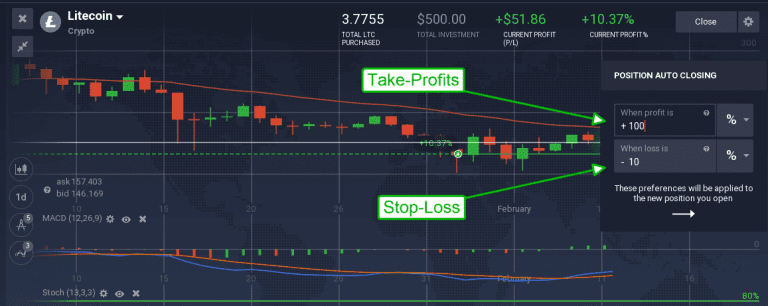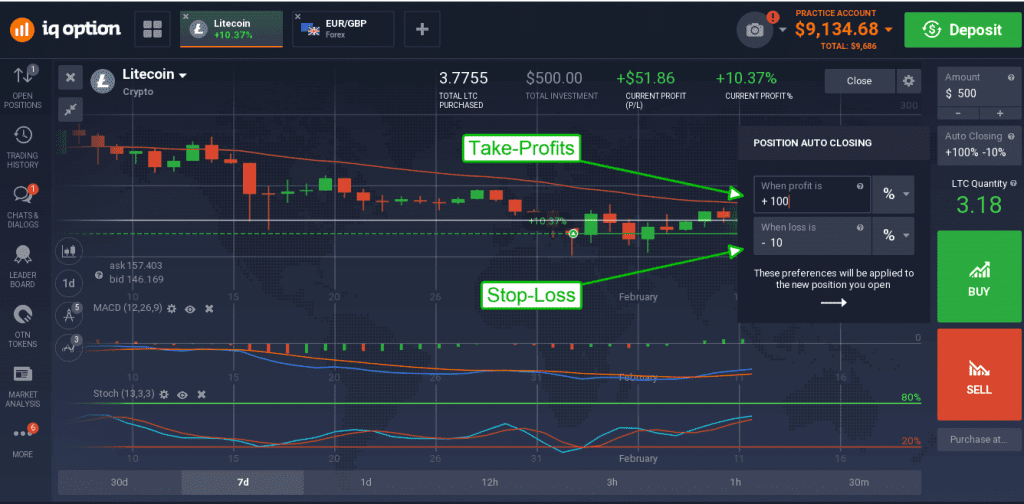Knowing when to take profits isn’t always easy. Technical targets are one method, the autoclose feature is another but both come with risks that can cost you money.
Profit targets or autoclose, you be the judge
Knowing when to take profits isn’t always easy. Technical targets are one method, using an autoclose feature like the one at IQ Option is another. Both methods seek to lock in and maximize profits, but both come with risks. On the one hand a technical target may not be reached, or it may be exceeded, and on the other an autoclose may trigger well before a move is done costing you percentage points of unrealized gains.
Technical Targets – Technical targets are price levels on the charts at which prices can be expected to halt or reverse, or price levels a move is projected to reach based on past price movement. What I can say for these targets is that, over the 12+ years I have been trading and chart watching I’ve seen these targets hit time and time again.

The only downside is that the time it takes for prices to reach those targets and what happens after they are reached is uncertain at best. This means that successful traders will have to sit and wait, watching for prices to reach their projected levels and decide; do I sell, or do I wait. If you sell you lock in profits and if you wait, you gamble on keeping what you have already worked hard to earn.
 The Autoclose Feature – Autoclose is one of the most useful tools of the successful trader. It’s most important function is as a stop-loss. By setting the autoclose to sell out at a loss of 10%, 20% or 30% traders can protect their capital and live to trade again another day. Without it traders risk losing 100% of their trades as they watch prices move in the wrong direction and wrestle with the decision to close out. What many traders do not realize is that the IQ Option autoclose has two settings; the first is for stop-loss, the second is for taking profits.
The Autoclose Feature – Autoclose is one of the most useful tools of the successful trader. It’s most important function is as a stop-loss. By setting the autoclose to sell out at a loss of 10%, 20% or 30% traders can protect their capital and live to trade again another day. Without it traders risk losing 100% of their trades as they watch prices move in the wrong direction and wrestle with the decision to close out. What many traders do not realize is that the IQ Option autoclose has two settings; the first is for stop-loss, the second is for taking profits.
Pros and Cons
- Pros of Autoclose – When a trader sets the take-profits to close a trade they are taking all emotion out of the decision. When profits reach a satisfactory amount, the trade is closed no questions asked. This means they don’t have to sit by and watch the trade freeing them up to do other things. Another pro is that it only takes one touch of the target level for the trade to trigger. This means that if prices are volatile and only reach the target level for a brief period the trade will close.
- Cons of Autoclose – When it comes to auto closure there is only one drawback, it can cost you money. I know that as many times as I’ve seen my profit targets reached I’ve seen them exceeded. This means that potential profits are often far greater than what I think is reasonable to expect. Setting the take-profit may guarantee a portion of the profit but it could cut you off from maximum profits.
How to use the autoclose feature
Using the autoclose feature is very simple. All you must do is set it to the percent of your capital that you want to protect in the event of loss or lock-in in the event of gains. A good rule of thumb for the stop-loss is 3% of the total account. If your total account is $10,000 then 3% of your account is $300 so set the stop-loss on every trade so you lose no more than $300. I like to set it so that my 3% of account is equal to about 30% of the trade. This means, in a $10,000 account, trades of $1000 are acceptable because you will only be losing $300 if it should fail.
Taking profits is a little more difficult but only because you want to lock in the most profits you can. I set my initial profit target at 50%. This means that if the trade should move up quickly and hit 50% I make $500 (assuming the $10,000 account balance). If prices begin to move in my direction but don’t hit my take-profit I then begin to adjust based on market conditions. The first thing to do it too slow raise the stop-loss to lock in more of your capital as the trade moves in your favor. The next thing to do is asses the technical targets for profit and the likelihood they will be reached; if necessary raise the take-profit limit to suit.


